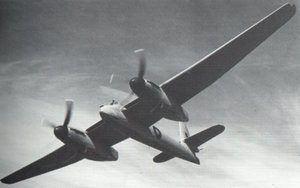Westland Welkin
|
|
The Welkin was a twin-engine heavy fighter from the Westland Aircraft company, designed to fight at extremely high altitudes in the stratosphere. It was created in response to the arrival of modified Junkers Ju 86 bombers flying reconnaissance missions which suggested the Luftwaffe might attempt to re-open bombing of England at high altitudes. In the end this threat never materialized, and the Welkin was produced only in small numbers.
The Welkin was essentially an evolution of the Whirlwind, fitted with a much larger wing, new engines in the form of Rolls Royce Merlin 76/77's, and a pressurized cockpit. The last item required the majority of the effort in designing the Welkin. After extensive development a new cockpit was developed that was built out of heavy-gauge duraluminum bolted directly to the front of the main spar. The cockpit hood used an internal layer of thick perspex to hold the pressure, and an outer thin layer to form a smooth line. Heated air was blown between the two to keep the canopy clear of frost.
The pressurization system was driven by a Rotol supercharger attached to the left-hand engine, providing a constant pressure of 3.5 lb/in² (24 kPa) over the exterior pressure. This resulted in an apparent altitude of 24,000 ft (7,300 m) when the plane was operating at its design altitude of 45,000 ft (13,700 m). This apparent altitude is still too high for normal breathing, so the pilot still had to wear an oxygen mask during flight. A rubber gasket filled with the pressurized air sealed the canopy when the system was turned on, and a valve ensured the pressure was controlled automatically.
Other than that, changes were minor. The wings were so large that the Fowler flaps used on the Whirlwind weren't needed, and were replaced by a simple split-flap. The extra wing area also required more stability, so the tail was lengthened to provide more arm.
By the time the plane was complete and rolling off the line, it was apparent that the Germans had lost interest in the high-altitude mission, due largely to successful interceptions by specially modified Supermarine Spitfires. In the end only 75 Welkins were produced. A two seat version known as the Welkin Mk. II was produced in only two examples.
The Welkin was seriously handicapped by compressibility problems exacerbated by its long but thick wings, causing the flyable speed range between high-incidence stall and shock-stall to become very small at high altitudes - any decrease in airspeed causing a 'normal' stall, any increase causing a shock-stall due to the aircraft's limiting critical Mach number. This reduction of the speed envelope is a problem common to all subsonic, high-altitude designs and also occurred with the later Lockheed U-2. When Harold Petter came to design his next aircraft, the English Electric Canberra, it was distinguished by noticeably short wings.
Specifications (Welkin)
General Characteristics
- Crew: one pilot
- Length: 41 ft 6 in (12.67 m)
- Wingspan: 70 ft 0 in (21.30 m)
- Height: 15 ft 9 in (4.80 m)
- Wing area: 250 ft² (23 m²)
- Empty: 8,310 lb (3,768 kg)
- Loaded: 10,356 lb (4,697 kg)
- Maximum takeoff: 11,410 lb (5,175 kg)
- Powerplant: 2x Rolls-Royce Merlin 76, hp ( kW) each
Performance
- Maximum speed: 385 mph (625 km/h)
- Service ceiling: 30,300 ft (9,237 m)
- Rate of climb: ft/min ( m/min)
- Wing loading: 41 lb/ft² (204 kg/m²)
- Power/Mass: hp/lb ( kW/kg)
Armament
- 4x 20 mm Hispano cannon in nose
External links
- Westland Welkin (http://www.military.cz/british/air/war/fighter/welkin/welkin_en.htm)
Related content
Related development: Westland Whirlwind (fixed wing)
Comparable aircraft:
Designation sequence:
|
Lists of Aircraft | Aircraft manufacturers | Aircraft engines | Aircraft engine manufacturers Airports | Airlines | Air forces | Aircraft weapons | Missiles | Timeline of aviation |

